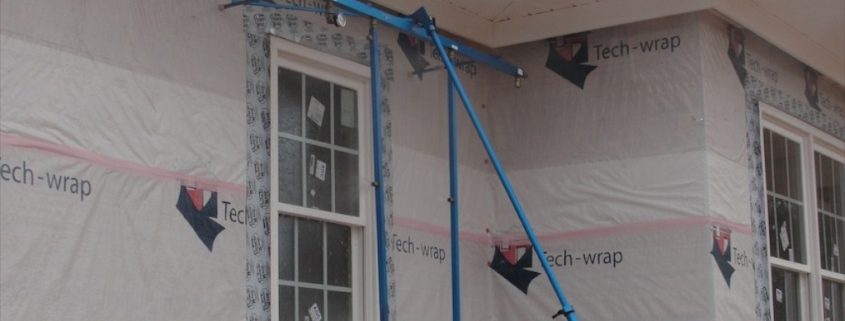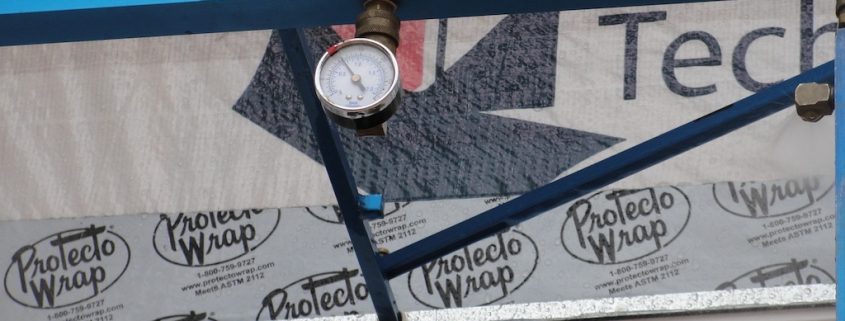
The AAMA 502 (Voluntary Specification for Field Testing of Newly Installed Fenestration Products) is a field-testing guide developed by the American Architectural Manufacturers Association (AAMA).
This guide illustrates test procedures to ensure air and moisture penetration is minimized in new window installations. In addition, the AAMA 502 guide provides verbiage that can be directly inserted into project specifications, saving time and effort. The only problem with the verbiage provided is that it is often inserted in a generic format that does not provide details as to the areas, quantity, and specific testing pressures.
It is up to the contractor to ensure these testing parameters are established. Once testing parameters are specified, the testing agency ensures that proper procedures were followed during the construction installation process.

The AAMA 502 is based on guidelines established by ASTM International, formally known as the American Society for Testing and Materials. The ASTM E 1105 (Standard Test Method for Field Determination of Water Penetration of Installed Exterior Windows, Skylights, Doors, and Curtain Walls) is used for water penetration testing, and the ASTM E 783 (Standard Test Method for Field Measurement of Air Leakage Through Installed Exterior Windows and Doors) is used for air infiltration testing.
Typically, a sampling of windows from the project is selected and tested. The construction contract will appoint a party responsible for the cost of the testing. The number of tests depends on the size and budget of the project. The project architect, manager, or owner specifies the amount and locations of the windows to be tested; this happens either early in the project or at three intervals in the case of large projects: 5%, 50%, and 90% completion. With a large project, testing early on can prevent expensive repairs if a design flaw is identified during the first phase of testing. Normally, if a window fails, the contractor should be prepared for a wider scope of testing.
One-week notice prior to water testing is usually given to all construction crew members concerned with window installation. It is not recommended to notify anyone of the actual test locations until the testing agency arrives onsite. If the installers know of the test locations, they will give these areas “special attention,” and testing results will not reflect accurate conditions. The whole idea of Quality Assurance / Quality Control (QA / QC) testing is to prevent water intrusions from occurring. In case of leaks, the installer, waterproofing contractor, or the manufacturer will have an opportunity to repair and/or replace the window, after which it will need to be re-tested. Water penetration observed when testing windows will be given extra attention for the remainder of the project.
Before testing, the window installation is visually observed. Are the edges perfectly horizontal and vertical? Is the window square? What is the drainage design? How is the installation quality? Have flashing and sealing been properly finished?
Then both air and water leakage (in that order) are determined using a test chamber of constant pressure. A predetermined amount of air leakage is allowable; however, no water leakage is permitted at all. A specified pressure is maintained while any escaping air is measured. Water leakage uses the same method while spraying the window from outside to observe indoor penetration.
Any moisture not coming in through the window, but getting in somehow, will be subject to further forensic investigation. Testing pressures should never exceed more than 2/3 of the product rating.
Guidelines for the type of equipment to use and test procedures to follow are specified in the AAMA 502. If the window installation was completed within 6 months, and there is not a building occupancy permit (CO), then the AAMA 502 is the right document to use. AAMA 511 procedures are required if there are residents in the building or the installation is more than 6 months old.
The AAMA 511 method will be used where water penetrates the building envelope, and ASTM E 2128 is an approved alternative method.
BDG utilizes professional testing equipment that is calibrated to each specific testing standard for accurate results. Our field consultants are properly trained and knowledgeable of all testing standards. BDG has extensive knowledge of most building systems and specializes in forensic water intrusion investigations. This allows us to not only properly test fenestrations on new construction projects, but also pinpoint the cause of any test failures and provide accurate recommendations to achieve successful testing results. Failures during quality assurance (new construction) testing can result in unnecessary delays that impact your bottom line.
If you are looking for a reputable second or third-party testing company to perform accurate professional testing, provide concise reports, and help you through the entire process, contact BDG today. We provide testing services throughout the United States from our headquarters located in Atlanta, GA.
Give us a call to discuss your next project.

